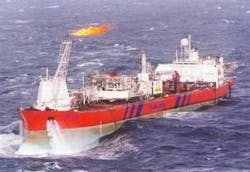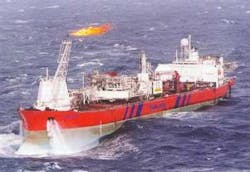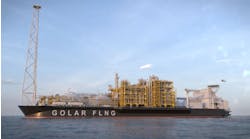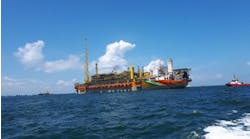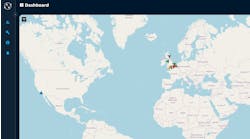Green water does great damage
Dr. Bas Buchner
Maritime Research
Institute Netherlands
Green water on the deck and waves impacting on the hull challenge the attractive FPSO concept. Both can put the ship, its crew, and sensitive equip-ment at risk. Several North Sea FPSOs in the UK and Norwegian sectors have already sustained damage from these wave forces.
FPSO in storm in the North Sea. (Used by permission from Bluewater Energy Services.)
null
Clearly, the design and operation of FPSOs should take into account these environmental factors. In recent years, research institutes and joint industry projects (JIPs) have studied green water and wave impact loading with interesting results.
Green water
In heavy storms, wave and vessel motions can become so large that water flows onto the deck of a ship. This problem is known as "green water loading." The term "green water" is used to distinguish between the spray (small amounts of water and foam) and solid seawater on the deck. For years, green water has been considered a serious threat to the safety and operability of naval and merchant vessels. Captain D. MacIntyre described the situation in The Battle of the Atlantic: "Their hulls whipped and shuddered in the huge Atlantic seasUsolid green water swept destructively along their decksU. For hour after hour this process repeated itself. Damage mounted, hull plates splitting, boats being smashed, men swept overboard and delicate anti-submarine devices put out of orderU."
Now that the use of ship-type offshore units for the production and storage of oil has become common, these units should be able to survive the most critical environmental conditions. This requires not only an adequate mooring system, but also attention to the potential problem of green water on the deck.
While tankers have an almost empty deck, FPSO decks, by definition, carry a lot of sensitive equipment. Consequently, green water can cause damage to the vessel's superstructure and equipment, such as the fluid swivels, piping, turret structure, control valves, emergency systems, fire detection/protection systems, and cable trays.
History of problems
Recent FPSO experience in the North Sea confirms the seriousness of the green water problem. From 1995 to date, 17 green water incidents have been identified on 12 UK FPSOs/floating storage units (FSUs). Some installations have experienced more than one incident. For instance, during a winter storm in January 1995, a firefighting platform was destroyed on the Emerald FSU. In January 2000, green water hit the living quarters on the bow of the Varg FPSO, damaging a window at the second floor and flooding the area behind it. The vessel was designed for green water loading, but an incorrect arrangement of the window resulted in the damage.
It was also found that in slightly non-collinear wind, waves, and current conditions, green water can wash over the deck from the sides of the ship. This can lead to dangerous shifting of equipment, such as containers, on the deck, as well as damage to the FPSO itself.
Green water from the side of the Norne FPSO resulted in some minor damage to the piping system in 1998. Evaluation of the vessel showed that the bow was also vulnerable to green water, prompting operational draft restrictions, which minimize the chance of shipping green water.
Finally, green water has been observed at the stern, particularly in the case of traditional converted tankers with no poop deck. Thus it is clear that FPSOs, designed according to existing class rules and regulations, still suffer from green water loading damage.
Model tests
The JIP on F(P)SO Green Water Loading formed in 1997 to deal with this problem.
The problem was studied in detail using an extensive series of model tests. The objective was to develop methods for evaluating green water on ship-type offshore structures based on a clear description of the green water physics.
The project was supported by a wide range of companies in the offshore industry. Participants include ABB Offshore Technology, Bluewater Engineering, BP, ChevronTexaco, ConocoPhillips, ExxonMobil, FMC Sofec, Germanischer Lloyd, Gusto Engineering, Health & Safety Executive in the UK, Mærsk Contractors, Samsung Heavy Industries, SBM, and Shell.
It was concluded that non-linear and highly complex phenomena occur in all phases of the green water problem, such that the green water problem cannot be predicted with existing linear prediction methods.
A semi-empirical design evaluation method was proposed, to predict the green water problem from the input (extreme relative wave motions) to the output (predicted load levels) based on a clear description of the green water physics. The complete method is included in the GreenLab program, which allows FPSO designers and operators to evaluate their FPSOs in field-specific environmental conditions.
SAFE-FLOW and ComFLOW
As a follow up of this research, in 2001 the three-year SAFE-FLOW project was initiated. The SAFE-FLOW project has 26 participants from all sectors of the offshore industry and is funded by the European Union under the Growth program.
The objective of the SAFE-FLOW project is to develop guidance, calculation methods, and risk assessment procedures for green-water and wave-impact loading. In addition to the green water problem, the project focuses on wave impact against the hull of FPSOs. This research was driven by the damage to the bow plating of the Schiehallion FPSO, which occurred in 1998 due to steep fronted waves slapping against the bow.
The project investigates the physics of extreme waves, the resulting hydrodynamic loading and structural response, and the related risk assessment procedures, all to improve the safety, reliability, and availability of floating offshore structures.
The project makes use of dedicated model tests to study the complex physics of the waves and their effects on the floating structures; however, based on a pilot study that was part of the SAFE-FLOW project, a significant step was made in the development, benchmarking, and validation of ComFLOW.
How the programs work
ComFLOW is an improved Volume of Fluid program using CFD code to compute non-linear wave loads on offshore structures. The program was developed initially by the University of Groningen in the Netherlands under Professor Arthur Veldman to study the sloshing of liquid fuel in satellites.
This micro-gravity environment requires a very accurate and robust description of the free surface. Coupled dynamics between the sloshing fluid and the satellite were investigated as well. In close cooperation with Maritime Research Institute Netherlands (Marin), this methodology was later extended to the calculation of green-water loading on a fixed-bow deck and the analysis of anti-roll tanks, including the coupling with ship motions. Finally the entry of a wedge in a fluid was studied as part of the RuG-Marin cooperation.
During the SAFE-FLOW project, significant progress was made in improving the numerical details of green water flow onto a moving deck. The study gave good quality peak-pressure distributions of critical equipment on the deck.
To use this type of pressure distributions in real structural design, the coupling of the pressure results from ComFLOW to finite element codes was developed. Because these types of calculations are very time consuming, it is necessary to constrain the detailed calculations to a limited domain close to the actual impact. A coupling was made between the local ComFLOW domain and 3D diffraction analysis, so that the global response of the vessel could still be calculated with existing tools.
Valuable tool
The experience with, and validation of, ComFLOW in the SAFE-FLOW project has given many of the participants confidence that it can be a valuable tool for the analysis of complex hydrodynamic problems in the offshore and shipping industry. Beside the subjects of green water loading and wave impact loading, the following topics were mentioned or investigated in pilot simulations:
- Run up against TLPs and semisubmersible columns or Spars
- Sloshing in (LNG) tanks and its possible effect on vessel motions
- Loads on subsea equipment in the splash-zone during installation
- Sloshing and efficiency of process equipment
- Efficiency of anti-roll tanks
- Wave-in-deck loads on fixed jacket structures
- Wave overtopping of gravity-based structures
- Loads from "freak" waves.
Pilot simulations of wave-in-deck loads and run-up calculations against TLPs, semisubmersible columns, and Spars already have been done.
null
Further development
SAFE-FLOW will be completed by the end of 2003. A large number of participants have already indicated they would like to proceed with the ComFLOW development. The research partners involved (University of Groningen/RuG and Marin in the Netherlands and CorrOcean in Norway) are enthusiastic about a further extension of their cooperation. The joint development of ComFLOW is being investigated in the ComFLOW-2 initiative. It will still have a clear research character (step-by-step discovery of new fields and thorough validation of results), but with a strong focus on the practicality of the developed tool as well.
The objective is to develop a user-friendly and well-validated numerical tool. Such a tool would be used by the offshore industry to study complex free surface problems. The tool would also be flexible in its application and have a coupling possibility to the other tools of participants. The planned start for this initiative is in the second half of 2003.
References
Green Water on Ship-type Offshore Structures, Bas Buchner, PhD thesis, Delft University of Technology.
Author
Dr. Bas Buchner is manager offshore of the Maritime Research Institute Netherlands (Marin), responsible for all offshore projects of the institute.
